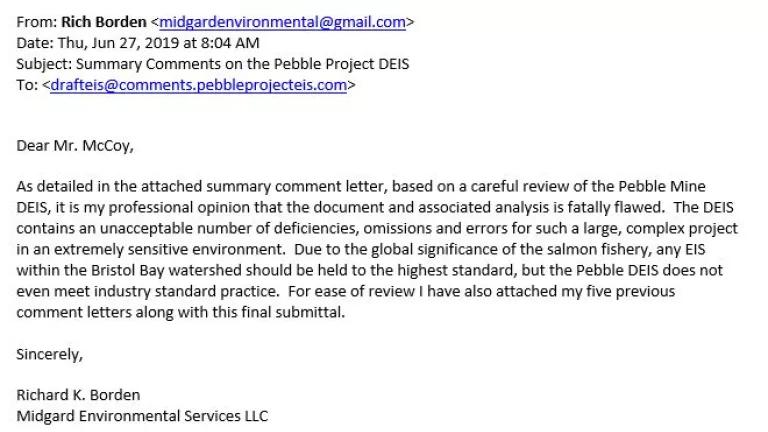Pebble Mine: The Industry’s Burden of Irresponsible Mining

Former Rio Tinto mine permitting expert calls Army Corps of Engineers environmental review of embattled Bristol Bay mine “fatally flawed,” citing numerous “omissions, deficiencies and errors” and failure to meet “standard industry practice.”
Don’t let anyone tell you that opposition to the reckless Pebble Mine is anti-mining or anti-copper. Society needs both. What we don’t need is the Pebble Mine.
Perhaps the most widely condemned development project anywhere, Pebble is in a risk class by itself—relentlessly opposed locally, an international pariah, a potential social and environmental disaster, and an embarrassment to the international mining community. At recent stakeholder meetings on responsible mining, it has been cited as the consensus poster child for how not to mine—hopeless siting, failed community relations, bad economics, and a litany of unjustifiable risk.
Over the past eight years, four major global mining companies (Mitsubishi Corporation in 2011, Anglo American in 2013, Rio Tinto in 2014, and First Quantum Minerals in 2018) have abandoned the project. Now only the small, underfunded Canadian owner Northern Dynasty Minerals remains.
Last week, with the public comment period closing on Pebble’s federal Army Corps of Engineers permit application, one commenter in particular attracted notice because of his unimpeachable industry credentials and detailed discussion of a range of “fatal flaws” in the Pebble project:
Richard Borden, a 23-year Rio Tinto mining expert, permitting specialist, and former Head of Environment for its copper, diamonds, and coal divisions, submitted a series of six detailed comment letters critiquing the project, its application, and its draft environmental impact statement (“DEIS”). The subject areas include (1) permitting schedule, (2) project economics, (3) geotechnical and spill risks, (4) reclamation and closure, (5) alternatives, (6) cumulative effects, (7) water management, (8) wetlands mitigation, and (9) air quality.
Given his unique experience in overseeing permitting for some 50 major Rio Tinto projects around the world, his findings are compelling—and they are damning. If the goal of an environmental review is the objective disclosure and analysis of impacts, alternatives, mitigation, and practicability—and it is—Pebble’s DEIS review is an unmitigated failure, from its “extraordinarily short time lines” to its “unacceptable number of deficiencies, omissions and errors.” According to Borden,
it is my professional opinion that the document and associated analysis is fatally flawed. The DEIS contains an unacceptable number of deficiencies, omissions and errors for such a large, complex project in an extremely sensitive environment. Due to the global significance of the salmon fishery, any EIS within the Bristol Bay watershed should be held to the highest standard, but the Pebble DEIS does not even meet industry standard practice.
In his most recent letter (dated June 18, 2019), he summarizes just a few of the glaring flaws discussed in extensive detail in his 47 single-spaced pages of comments. For example:
Economic Infeasibility
The 20-year mine plan being evaluated by the Pebble Mine EIS process is almost certainly not economically feasible. It only targets about ten percent of the total resource and by necessity must process relatively low-grade ore. It only produces half as much metal for sale as the smallest mine plan economic evaluation which is publicly available (Wardrop, 2011, Preliminary Assessment of the Pebble Project). Based upon an independent analysis of project economics, the mine plan being evaluated by the DEIS has been estimated to have a net present value of roughly negative three billion dollars (Borden, 28 March). Furthermore, the closure of even this relatively small mine is almost certain to cost in excess of 1.5 billion additional dollars (Borden, 31 May).
Cumulative Effects Analysis
The cumulative effects analysis for the expanded mine case evaluated in the DEIS contains insufficient detail, understates the impacts of a larger mine and in some cases its conclusions are clearly wrong. Most of the individual impacts and risks for the 78-year mine will be at least three to seven times greater than for the small 20-year mine (Borden, 17 June). However, the geochemical and water quality risks posed by the larger mine will be at least ten times greater. The mine would also need to manage five times more tailings and one hundred times more waste rock with an associated increase in the risk of catastrophic containment failure. It is certain that this larger mine would lead to measurable, significant and permanent harm to fisheries in the Bristol Bay watershed even if everything were to go according to plan.
Geotechnical and Spill Risks
Given the very high innate geotechnical risk of the Pebble Mine setting and the extreme sensitivity of the downstream receiving environment, the DEIS analysis of tailings and untreated water release is clearly inadequate. Large-scale catastrophic release of tailings and contact water is one of the most significant risks posed by the Pebble project and the DEIS’ intentional failure to evaluate the impacts of any catastrophic release events cannot be justified. By ignoring all potential catastrophic failure events, the release scenarios evaluated by the DEIS are anomalously small, representing only 1) 0.004% of produced bulk tailings that must be contained on-site forever; 2) 0.6% of produced pyritic tailings that must be contained on-site during operation; and 3) 0.4% of untreated process water that must be contained on-site during operation. Even a release of just five percent of the bulk or pyritic tailings is likely to have profound, permanent negative impact on downstream aquatic ecosystems and fisheries.
Reclamation and Closure
Despite the significant post-operational environmental impacts and risks at Pebble, no Reclamation and Closure Plan has been completed and the closure analysis within the DEIS is clearly inadequate (Borden, 31 May). The lack of even a conceptual level plan is a particular concern because closure of the 20-year Pebble mine will be complex and very costly (almost certainly exceeding 1.5 billion dollars). Water treatment for flows in excess of 5000 gallons per minute will be required for centuries after mining is completed. Completion of a Reclamation and Closure plan during the EIS process is common practice within the mining industry.
Wetlands Mitigation
Mitigation actions at Pebble will be critically important given the project’s unavoidable, permanent large-scale impacts to an extremely sensitive and economically valuable receiving environment. Unfortunately, many of the actions presented in the DEIS are so poorly-defined that it is impossible to assess if they would provide adequate and meaningful mitigation for the project’s impacts (Borden, 17 June)... [N]o actual potential mitigation projects are identified in the DEIS or in the Draft Conceptual Compensatory Mitigation Plan (CMP) (Appendix M). Instead the CMP only discusses generic evaluation criteria for the selection of currently unidentified mitigation projects to be identified at some future time.
Water Management
Given the very high geochemical risk of the Pebble orebody, the extremely wet climate and the extreme sensitivity of the Bristol Bay watershed, water management at the proposed mine is an issue of critical importance...I am not aware of a treatment flowsheet of this complexity being applied to such high flows anywhere else in the world. Many of the water management strategies and systems described in the DEIS are flawed or lack sufficient design detail to evaluate whether they are adequate and practicable to meet the required very high standard for water management (Borden, 14 June). Problematic water management issues include but are not limited to 1) water treatment practicability, 2) constructability and performance of water containment structures, 3) groundwater quality impacts, and 4) water treatment requirements during construction.
Air Quality Predictions
It appears that air quality modeling did not consider the impact of tailpipe (mobile) emissions on the surrounding airshed (Borden, 17 June). If tailpipe emissions from haul trucks and other mobile equipment have truly been omitted from the dispersion modelling, this represents a fatal flaw in the air quality predictions, particularly for nitrogen oxides (NOx). The DEIS emissions inventory indicates that 97% of all NOx emissions from the mine result from tailpipe emissions. Air quality impacts are likely to be much greater than currently implied by the DEIS . . . .
Underlying each of these general findings are individual letters detailing a litany of specific deficiencies.
For example, in the case of geotechnical issues—that is, whether the document adequately analyzes the potential for a significant breach of containment and a spill of mining waste or other contaminants from the site—Borden finds the analysis “clearly inadequate,” failing not only to “definitively demonstrate the geotechnical stability of tailings embankments, water storage facilities and pit walls throughout operation and closure” but unjustifiably failing to analyze “the impacts of any catastrophic release” at all. Remarkably, the only bulk tailings release scenario that is evaluated by the DEIS “assumes a brief six-hour pipeline break and therefore does not even consider containment failure associated with the tailings storage facility itself.”
And he goes on to lay out a series of underestimates, omissions, and concerns too numerous to summarize here about the unacceptable level of geotechnical risk ignored by Pebble in its DEIS.
Suffice it to say that each of his comment letters, on each of the subject areas, is infused with a similar level of detail and analysis, based on his unimpeachable expertise, his decades long experience in the industry, and his independent perspective. As a result, his overarching conclusion – that the DEIS is “fatally flawed” and “does not even meet industry standard practice” – is clear, convincing, and alarming.
Ultimately, he concludes that the EIS process will be “severely compromised” unless the DEIS is redone:
Given the substantial flaws in the DEIS, I would strongly urge the Army Corps of Engineers to restart the process with an analysis based on an economically-credible mine plan, supported by an independent, rigorous economic analysis demonstrating that the project is the least environmentally damaging practicable alternative. The EIS process will be severely compromised if the deficiencies of the current document are not fully addressed; this would, at a minimum, necessitate the completion of a Supplemental Environmental Impact Statement, recirculated in draft for public comment.
The Pebble Mine DEIS—full of critical omissions and failures to analyze significant risk – is not what the National Environmental Policy Act (“NEPA”) and the federal Clean Water Act require. The conclusion is inescapable that its “fatal flaws” are the direct result of Pebble’s prioritization of its own financial pressures over the public’s interest in a sound environmental review, a legally adequate permit, and—ultimately—mine safety.
This is the definition of irresponsible mining, and Pebble is its poster child.
The people of Bristol Bay have demanded, and they are entitled to expect, a meaningful opportunity to participate in a fair-minded permitting process that is objective, transparent, thorough, and in compliance with the law. From a longtime veteran of the industry, Richard Borden’s critique of Pebble’s DEIS has confirmed their fear that this standard will not be met at Pebble.




